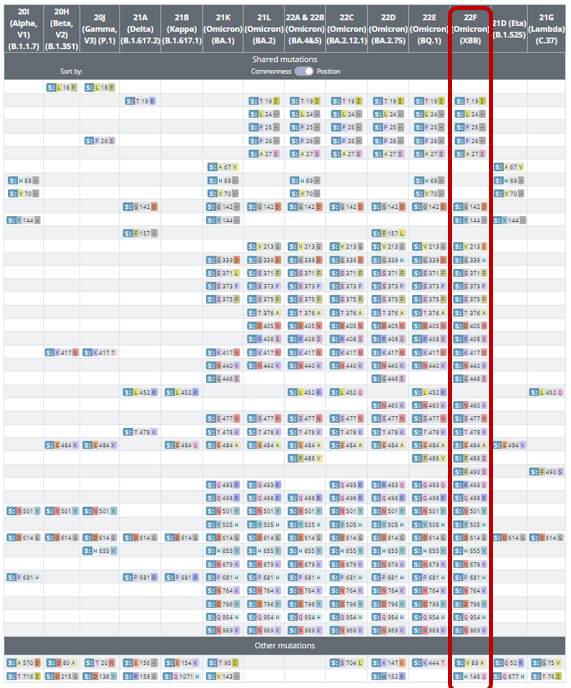
🎉CoVariants.org Update!🎉
22F (XBB) is now available on CoVariants! It's visible as part of Per Country & Per Variant plots, on the shared mutation page - and of course, has a page of its own.
1/9
#XBB #22F
22F (XBB) is now available on CoVariants! It's visible as part of Per Country & Per Variant plots, on the shared mutation page - and of course, has a page of its own.
1/9
#XBB #22F

This is in line with the recent addition of 22F (XBB) as a @nextstrain clade - read more on that below! 👇🏻
2/9
2/9
https://twitter.com/nextstrain/status/1588313824301649920
As I tweeted earlier, 22F (XBB) is a recombinant variant - the first officially elevated using the Nextstrain clade designations. You can read more about what that means in the thread below!
3/9
3/9
https://mobile.twitter.com/firefoxx66/status/1587762412110974976
On the 22F page, you can read about some initial 22F / XBB work on neutralizing titres, see a list of defining mutations, a plot of the variant growth, link to Aquaria protein viz, & see a list of other mutations present in the variant.
4/9
covariants.org/variants/22E.O…

4/9
covariants.org/variants/22E.O…


There's also a link to the 22F / XXB @nextstrain focal build: nextstrain.org/groups/neherla…
Here, we can zoom in on the clade & get a closer look at how 22F sequences are distributed around the world, & their diversity.
5/9

Here, we can zoom in on the clade & get a closer look at how 22F sequences are distributed around the world, & their diversity.
5/9


On the Per Country page, 22F / XBB is already clearly visible in India & Singapore, & starting to appear in smaller numbers in other countries, like Austria & Australia. Remember that sequencing data is always a few weeks (at least) behind.
6/9
covariants.org/per-country
6/9
covariants.org/per-country

Finally, on the Shared Mutations page, you can see how 22F's / XBB's Spike mutations compare to other VoC, including its Omicron family.
7/9
covariants.org/shared-mutatio…
7/9
covariants.org/shared-mutatio…

More information on 22F / XBB will become available in due course.
As always, CoVariants.org is open-source & we welcome your PRs & suggestions to add more studies & information to variant pages! (Or any error-catching!)
github.com/hodcroftlab/co…
8/9
As always, CoVariants.org is open-source & we welcome your PRs & suggestions to add more studies & information to variant pages! (Or any error-catching!)
github.com/hodcroftlab/co…
8/9
As before, I've created a file for 22F / XBB mapping all defining mutations (relative to ancestral), including nuc->AA. This is available on CoV github!
Huge 🙏🏻 to all who helped check it! (Esp @DoktorYak @CorneliusRoemer & @ChaoranChen_ !)
github.com/hodcroftlab/co…
9/9
Huge 🙏🏻 to all who helped check it! (Esp @DoktorYak @CorneliusRoemer & @ChaoranChen_ !)
github.com/hodcroftlab/co…
9/9

• • •
Missing some Tweet in this thread? You can try to
force a refresh















